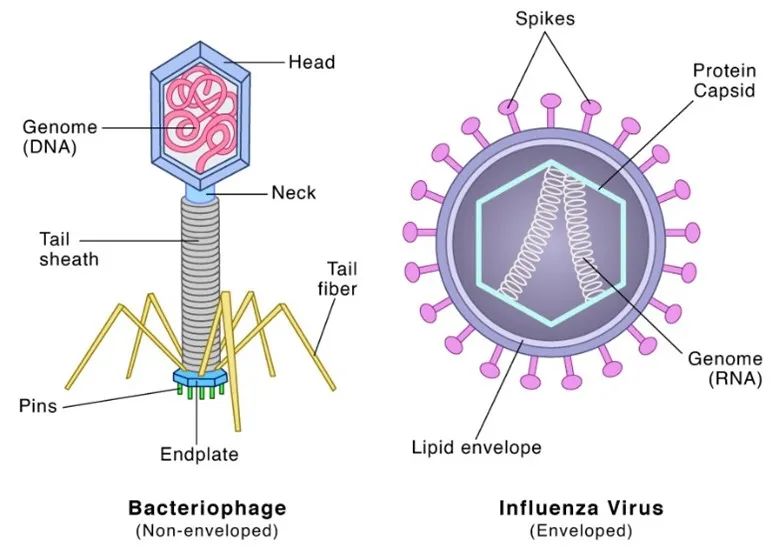
Lesser Cold's first visit to Meihualing, thousands of gullies Qianyan back human environment.
Qingyuan chatting as a pan-house line, a dream clearly fell into the hometown well.
Su Shi in the Northern Song Dynasty
Minor Cold is the fifth solar term in winter.Lesser Cold means it's very cold, but it hasn't reached the extreme yet. Because of the cold, many customs have evolved, such as eating food that protects against the cold, mutton noodles, pork and cabbage stewed noodles and so on.
This solar term popular science will introduce to youThe structure and life cycle of viruses.
Virus is a kind of acellular life form, which is small and simple in structure, and can infect other organisms and spread among them.
Although viruses show biological and abiotic characteristics, to some extent, viruses cannot be said to be living things, becauseThey lack most of the characteristics of living things.For example, they are acellular in origin (not made up of living cells), cannot grow and replicate independently without host organisms, and lack their own metabolic mechanisms.
Basic virus structure
It consists of two parts:
1. Nucleic acid genome (Genome)The genetic material of most viruses is double-stranded deoxyribonucleic acid (dsDNA), with some exceptions. The genetic material is single-stranded deoxyribonucleic acid (ssDNA) or ribonucleic acid (RNA). Its function is to provide genetic information to help synthesize new viruses in the host.
2. Protein capsid (Capsid)It is the protein shell that wraps the genome of the virus and helps the virus penetrate the host cell membrane and protects the genetic material of the virus from being digested by the enzymes of the host cell. In addition, the surface of the protein capsid contains unique sites that enable the virus to attach to the host cell.
In addition, there is a layer outside the protein capsid of many animal virusesLipid coating (Envelope)It consists of a lipid bilayer and proteins attached to it.
The envelope can help the virus better enter the host body, protect the genetic material of the virus from being destroyed by the host enzyme, and escape the recognition of the host immune system. Many viruses also form a special structure of glycoproteins on the envelope, calledSpinous process (Spike)The spinous process determines the specificity of virus infection and can help the virus identify and enter specific host cells.

Structure of the virus
Bacterial phage(left, unenveloped virus); influenza virus (right, enveloped virus)
(source: https://www.sciencefacts.net/virus-structure.html)
The virus itself cannot metabolize.It must be parasitic in living cells in order to replicate and proliferate.. It can use the nucleotides and amino acids of host cells to independently synthesize its own components such as DNA or RNA and proteins, and assemble the next generation of individuals.
Replicated biological viruses can be released through the cleavage of host cells to infect new host cells. This unique way of proliferation makesViruses proliferate faster than other organisms such as bacteria.But also because the virus does not have its own metabolic mechanism and enzyme system, once the virus leaves the host cell, it has no life activity and cannot reproduce itself.



A typical virus life cycle consists of the following main steps:
1
AttachmentThe virus recognizes and binds to the host cell with the help of receptor molecules
2
EnterThe whole virus (envelope virus) or its genetic material (non-envelope virus) enters the cytoplasm of the host and then enters the nucleus
3
CopyThe viral genome is replicated and its genes are expressed to make viral proteins
4
AssemblyThe new virus is formed by the assembly of genomes and proteins in the host
5
ReleaseComplete viral particles leave the cell and infect other host cells.

The life cycle of the virus
Bacterial phage(left, unenveloped virus); influenza, HIV and other viruses (right, enveloped virus)
(Source:https://studymind.co.uk/notes/life-cycle-and-replication-of-viruses/;https://chemistrytalk.org/viral-life-cycle/)

Science popularization of Hanning's "24 solar terms"It is a popular science column about microorganisms launched by Hanning Chemistry. Taking the traditional Chinese solar terms of 24 as the timeline, we regularly publish popular science essays on topics related to microbiology."the four seasons are orderly, everything is sometimes", let's "send knowledge in the season"To explore the microbial world togetherHanning will make an appointment with you at the right time and never part until we see you again.